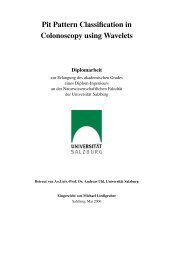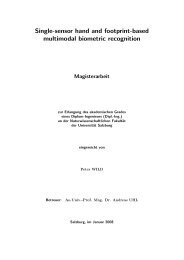1A <strong>Survey</strong> <strong>of</strong> <strong>H.264</strong> <strong>AVC</strong>/<strong>SVC</strong> <strong>Encryption</strong>Thomas Stütz and Andreas UhlAbstract—Video encryption has been heavily researched in therecent years. This survey summarizes the latest research resultson video encryption with a special focus on applicability andon the most widely-deployed video format <strong>H.264</strong> including itsscalable extension <strong>SVC</strong>. The survey intends to give researchersand practitioners an analytic and critical overview <strong>of</strong> the state-<strong>of</strong>the-art<strong>of</strong> video encryption narrowed down to its joint applicationwith the <strong>H.264</strong> standard suite and associated protocols (packaging/ streaming) and processes (transcoding / watermarking).ScalableCodingScalableCodingI. INTRODUCTION<strong>H.264</strong> is the most widely-deployed video compression systemand has gained a dominance comparable only to JPEGfor image compression. The <strong>H.264</strong> standard has also beenextended to allow scalable video coding (as specified inAnnex G [27], referred to as <strong>SVC</strong> within this work) with abackwards compatible non-scalable base layer (non-scalable<strong>H.264</strong> bitstreams referred to as <strong>AVC</strong> in this work). Thisextension enables the implementation <strong>of</strong> advanced applicationscenarios with <strong>H.264</strong>, such as scalable streaming and universalmultimedia access [69]. Given the dominant application <strong>of</strong><strong>H.264</strong> as video compression system, the necessity <strong>of</strong> practicalsecurity tools for <strong>H.264</strong> is unquestionable. In this survey wepresent an overview, classification and evaluation <strong>of</strong> the state<strong>of</strong>-the-art<strong>of</strong> <strong>H.264</strong> encryption, a topic to which numerousproposals that have been made. The survey focuses solely on<strong>H.264</strong> <strong>AVC</strong>/<strong>SVC</strong> encryption and intends to give researchersa brief, yet comprehensive survey and to aid practitioners inthe selection <strong>of</strong> <strong>H.264</strong> encryption algorithms for their specificapplication context. Furthermore, the survey identifies the mostrelevant research questions in the area <strong>of</strong> video encryption, thatstill need to be answered in order to leverage the deployment<strong>of</strong> <strong>H.264</strong> encryption.A secure approach to encrypt <strong>H.264</strong>, also referred to as“naive” encryption approach, is to encrypt the entire compressed<strong>H.264</strong> bitstream with a secure cipher, e.g., AES [49],in a secure mode, e.g., CBC (cipher block chaining mode).There are well-founded reasons not to stick to this approach,but to apply specifically designed encryption routines:• The implementation <strong>of</strong> advanced application scenarios,such as secure adaptation, transparent / perceptual encryptionand privacy preserving encryption.• The preservation <strong>of</strong> properties and functionalities <strong>of</strong>the bitstream, such as format-compliance, scalability,streaming / packetization, fast forward, extraction <strong>of</strong>subsequences, transcodablity, watermarking, and errorresilience.• The reduction <strong>of</strong> computational complexity (especially inthe context <strong>of</strong> mobile computing).Secure adaptation requires a scalable bitstream and specific encryptionroutines that preserve the scalability in the encryptedFig. 1.SPS PPS <strong>AVC</strong> <strong>SVC</strong> <strong>SVC</strong>Scalable<strong>Encryption</strong>SPS PPS <strong>AVC</strong> <strong>SVC</strong> <strong>SVC</strong>SecureAdaptationSPS PPS <strong>AVC</strong> <strong>SVC</strong> <strong>SVC</strong>(a) Secure adaptationSPS PPS <strong>AVC</strong> <strong>SVC</strong> <strong>SVC</strong>Transparent<strong>Encryption</strong>SPS PPS <strong>AVC</strong> <strong>SVC</strong> <strong>SVC</strong>ConventionalDecoding(b) Transparent encryptionSecure adaptation and transparent encryptiondomain (see figure 1(a) ). Secure adaptation is the basis forsecure scalable streaming [70], where secure adaptation isemployed in a multimedia streaming scenario. A secure streamfor a mobile phone (low bandwidth, low resolution display,low computing power) and a personal computer (high bandwidth,high resolution display, high computing power) can begenerated from the same secure source stream (by secure adaptation)without the necessity <strong>of</strong> the secret key, thus enablingcreator-to-consumer security. Transparent encryption denotesencryption schemes where a low quality can be decodedfrom the ciphertext; this functionality can be implementedwith scalable bitstreams (see figure 1(b)) by encryption <strong>of</strong>the enhancement layers. Privacy preserving encryption shouldconceal the identify <strong>of</strong> persons, an exemplary implementationis shown in figure 2.The remainder <strong>of</strong> the paper is structured in the followingway: <strong>H.264</strong> is briefly summarized in section II. In section IIIapplication scenarios <strong>of</strong> video encryption are discussed and
2(b)Figure 2: Scrambling for “Hall Monitor”:Fig. 2. Privacy preserving encryption: DCT coefficients permutation (figuretaken from [13], figure 2 (b), p.1171)NUT Description <strong>AVC</strong> class <strong>SVC</strong> class0 Unspecified Non-VCL Non-VCL1 Non-IDR slice VCL VCL5 IDR slice VCL VCL6 SEI Non-VCL Non-VCL12 Filler data Non-VCL Non-VCL14 Prefix NAL Non-VCL Variable16 . . . 18 Reserved Non-VCL Non-VCL20 <strong>SVC</strong> slice Non-VCL VCL21 . . . 23 Reserved Non-VCL Non-VCL24 . . . 31 Unspecified Non-VCL Non-VCLTABLE ISELECTED NAL UNIT TYPES.their corresponding different notions <strong>of</strong> security are motivatedand defined. The application context also requires that thevideo encryption scheme preserves functionality <strong>of</strong> the videobitstream; details are discussed in this section as well, whichends with the presentation <strong>of</strong> our evaluation criteria for avideo encryption scheme. In section IV <strong>H.264</strong> compressionand encryption are discussed jointly in detail. This approach<strong>of</strong> presentation was chosen to keep the level <strong>of</strong> redundancylow. Having discussed implementation and technical issues <strong>of</strong><strong>H.264</strong> video encryption schemes, section V proposes solutionsand discusses the proposed schemes with respect to the securityand application scenarios. Further research directions arediscussed in section VI and finally we conclude in section VII.II. OVERVIEW OF <strong>H.264</strong> <strong>AVC</strong> / <strong>SVC</strong>The <strong>H.264</strong> standard specifies the syntax and semantics <strong>of</strong>the bitstream together with a normative decoding process [27].However, it is <strong>of</strong>ten and especially in the context <strong>of</strong> <strong>H.264</strong>encryption more convenient to consider the encoding process.The raw video data is input to the encoder, the output is thebitstream in the NAL (network abstraction layer) format, i.e.,a series <strong>of</strong> NAL units (see figure 3). The NAL units have aplaintext header indicating the type <strong>of</strong> data in <strong>AVC</strong> as shownin figure 4 in which the entire <strong>H.264</strong> NAL header is outlined.The NAL header consists <strong>of</strong> the forbidden zero bit (F), a 3-bitfield signalling importance <strong>of</strong> the NALU (NRI), and the NALunit type (NUT). The most common NUTs are summarized intable I, NALUs with a unspecified NUT have to be discardedby the decoder.These NAL units are commonly packaged in a containerformat for transmission and storage. A typical <strong>H.264</strong> encoderhas the structure as outlined in figure 6. Important parts aremotion estimation (ME in figure 6) and motion compensation(MC in figure 6). Novelties in <strong>H.264</strong> compared to previousvideo coding standards are intra prediction (Intra pred in figure6) and in-loop deblocking filtering, i.e., reference pictures arefiltered to reduce blocking artifacts prior to motion estimationand compensation. A 4x4 DCT-based transform is applied (Tin figure 6), followed by quantization (Q in figure 6). Thereare two types <strong>of</strong> entropy encoding in <strong>H.264</strong>, namely CAVLC(context adaptive variable length coding) and CABAC (contextadaptive binary arithmetic coding).SPS PPS <strong>AVC</strong> <strong>SVC</strong> <strong>SVC</strong> <strong>AVC</strong> <strong>SVC</strong> <strong>SVC</strong> <strong>AVC</strong> <strong>SVC</strong> <strong>SVC</strong>Header RBSP <strong>AVC</strong> Header RBSP <strong>SVC</strong> Header RBSP <strong>SVC</strong> Header RBSPSPS Header RBSP PPSFig. 3. A mapping <strong>of</strong> video data to <strong>H.264</strong> <strong>SVC</strong> NALUsF NRI NUTFig. 4. NAL unit header structure.. . . PID . DID QID TID . . .Fig. 5. NAL unit header <strong>SVC</strong> extension structure.Fig. 6. <strong>H.264</strong> compression overview








